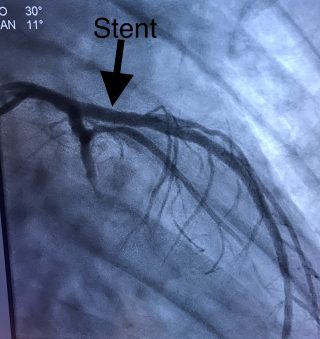There are many risk factors that contribute to the development of the blockages of the heart otherwise known as atherosclerosis. These include smoking, diabetes, obesity, high blood pressure, high cholesterol, inactivity or lack of exercise, and some genetic conditions.
The five major signs of a heart attack include chest pain, discomfort in jaw, neck, or back, shortness of breath, arm or shoulder pain, and feeling weak or faint.
If you develop any of the signs or symptoms of a heart attack you should immediately call 911 and chew an aspirin, unless you are allergic to aspirin. Make sure that you don’t drive yourself to the hospital as your condition might worsen and you might end up in a car accident further injuring yourself and others. Time is muscle, and what that means is that the faster the doctors are able to open up the blocked artery the more muscle is saved and less damage to the heart pump occurs. In general if a heart artery is opened within 90 minutes of the onset of symptoms, the majority if not all of the heart muscle at risk could be saved.
For this to happen you would need to get to the hospital as soon as possible. Once you arrive at the hospital the doctors usually do an EKG to confirm the heart attack and will start you on blood thinners to help dissolve the clot. Most patients will be taken to the Cardiac Catheterization Laboratory where the doctors perform an angiography to visualize the coronary arteries and open up the blockage using balloons and stents. In some cases stent placement may not be feasible or the patient may need open heart surgery to fix the blockage(s).
A coronary blockage before (left) and after treatment with a coronary stent (right).
Once the acute event is treated you will most likely be started on multiple medications to help treat and help prevent another heart attack. These medications include blood thinners like aspirin to keep the arteries open, cholesterol reducing medications such as statins and a variety of other medications including beta blockers to reduce the stress on the heart. Your doctor might also change you diabetic and or hypertension medications in order to better control these conditions. Most patients are also asked to participate in a rehabilitation program for a few weeks where they are monitored closely during physical exercise.
Consultation with a nutritionist is also recommended in order to prevent any bad dietary habits. Following hospital discharge you should usually see your cardiologist within a week or two to review your condition and medications. Make sure to bring your medications and a list of any questions you might have with you to your visit. Be prepared to ask questions and take notes as your doctor may set some physical activity, dietary, and other goals for you to follow. Some of these goals may include an LDL cholesterol goal of less than 70, blood pressure goal of less than 130 over 80, and a hemoglobin A1c level of less than 7.








